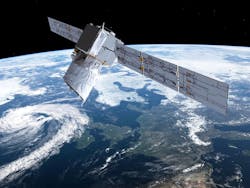NASA scraps study to use lidar space sensors for climate monitoring of aerosols, clouds, and precipitation
GREENBELT, Md. – U.S. space Earth-observation experts are scrapping a study to determine the feasibility of using light detection and ranging (lidar) technology to monitor the interaction among aerosols, clouds, atmospheric convection, and precipitation in Earth's upper atmosphere.
Officials of the National Aeronautics and Space Administration (NASA) Goddard Space Flight Center in Greenbelt, Md., had announced the Atmosphere Observing System-Polar (AOS-P) Lidar Instrument Study in early April, but announced Friday that the agency no longer plans to proceed with the AOS-P Lidar Instrument Special Study procurement. No reason was given.
The AOS-P lidar study was to be part of the larger AOS Lidar Instrument procurement, and was to study instrument concepts for the AOS-P mission, and assess future performance, technological maturity, and developmental risk.
The future Atmosphere Observing System (AOS) is to help optimize how NASA uses space sensors to examine links among aerosols, clouds, atmospheric convection, and precipitation.
AOS will deliver data for improved weather forecasts, as well as air quality and climate monitoring by increasing the understanding of the vertical structure of Earth's atmosphere with observations from space, skies, and the ground.
AOS still is to make the first-ever global measurements from space that reveal how ice and water move vertically within clouds; measure how clouds transfer heat; help scientists understand atmospheric aerosols; and develop space-based sensors.
The intent is to help scientists improve their understanding of climate change and severe weather; how to mitigate natural hazards and fight forest fires; and improve farming practices in the future.
The Lidar Special Study was to compare potential future Earth-observation instruments, as well as identify necessary hardware, software, and risk mitigation. The intent is to help NASA understand system design viability and risks. It was to help improve requirements in a future lidar instrument solicitation.
In May NASA issued a presolicitation (80GSFC23R0024) for the Atmosphere Observing System-Polar (AOS-P) Polarimeter Instrument Phase A Study to suggest potential sensors to support future AOS-P missions, and how these concepts meet performance targets, maturity, and acceptable risks.
The Polarimeter Phase A Study is being procured as a component of the larger AOS Polarimeter Instrument procurement. The study will assess instrument concepts; explore the feasibility of future sensor enhancements; possible development schedules and costs; and identify hardware, software, and risk mitigation.
Related: JASR Systems eyes chip-scale lidar for 3-D mapping, navigation, and communications
Polar orbits place sensors and electronics in hazardous environments because of high radiation levels, which require radiation-hardened electronic components, as well as other safeguards to protect orbiting electronics from the harsh environment of polar orbit.
The study will tell NASA about the feasibility and risks of current Polarimeter requirements and design concepts, and help improve requirements for a potential Polarimeter Instrument solicitation.
More information is online at https://sam.gov/opp/237538f5ce9e4a0486e41f277d08791e/view.
About the Author
John Keller
Editor-in-Chief
John Keller is the Editor-in-Chief, Military & Aerospace Electronics Magazine--provides extensive coverage and analysis of enabling electronics and optoelectronic technologies in military, space and commercial aviation applications. John has been a member of the Military & Aerospace Electronics staff since 1989 and chief editor since 1995.
